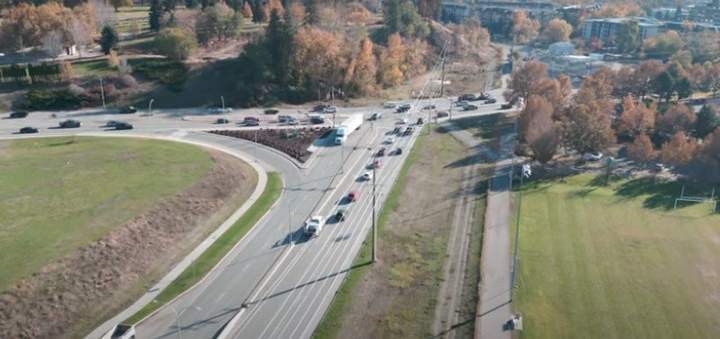As Kelowna, B.C., grows, so do traffic woes.
But one of the latest projects aimed at reducing congestion in the city’s midtown area is raising concerns.
“I’d like the city to take this road off the books,” said Rebecca Tyson, the president of the Save the Rail Trail Green Space Association, a group she started in opposition to the Clement Avenue Road Extension project.
The city, with some provincial financial help, plans to extend Clement Avenue by 2.4 km between Spall Road and Highway 33.
“We’re going to have approximately 50,000 residents in the next 20 years increase,” said Brittany Hallam, manager of the city’s integrated transportation department. “We need to plan for that future.”
Hallam said the Clement Avenue Extension project will add another route to run parallel to Enterprise Way, Highway 97 and Springfield Road.
“There are only three routes, transportation routes to get from the east side of the city to the west side,” Hallam said. “The Clement Avenue extension is a fourth route to get from east to west.”
However, the project will mean the re-alignment of some sections of the Okanagan Rail Trail, a bike and pedestrian path.
“Everybody feels safe on the rail trail. The minute you put a road beside it, some people start feeling less safe,” Tyson said.
Get breaking National news
For news impacting Canada and around the world, sign up for breaking news alerts delivered directly to you when they happen.
Tyson rides the rail trail regularly to get to work at UBC-Okanagan.
In addition to safety concerns, Tyson also worries green space will be lost.
“We’ve lost so much of our riparian area and our riparian areas, they clean the water, they clean the air,” said Tyson.
According to Hallam, the city is taking all of that into consideration.
“We’re looking at trying to get, based on our constraints, as much physical space from the trail and the road, vegetative space or grade separation.” Hallam said.
Tyson also questions the price tag of the project.
It’s pegged at $135 million, a cost the city says is related to some of the complexities along that transportation corridor.
“There is a lot of conflicting demands and needs in this corridor. There are large utilities, there are Fortis utilities. We’re looking at topographical constraints. We’re looking at riparian areas for the creek,” Hallam explained.
“There are three retaining walls required on this project, which are costly in itself.”
Tyson, who is a math professor with a physics degree, also said that based on her calculations, the new stretch of road would only save drivers up to 90 seconds.
But Hallam disagreed, adding calculating time saved on the road isn’t that simple.
“To put numbers out there, like 90 seconds, it really doesn’t contextualize what we’re talking about,” Hallam said.
“If we’re talking about where people are going, the routes they’re taking, time of day, time of week, which all would change what that time savings would look like.”
An online petition has garnered almost 1,200 signatures opposing the project.
The city is waiting for more provincial funding, but hopes to get the road extension construction started in late 2027 or early 2028.
© 2025 Global News, a division of Corus Entertainment Inc.


